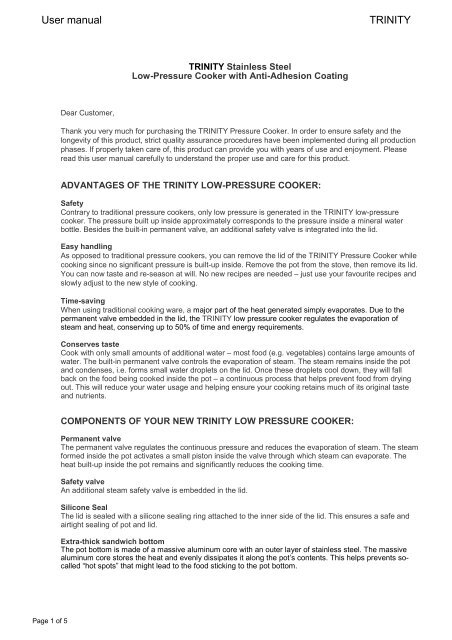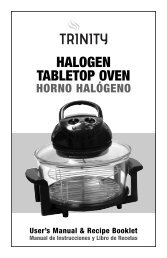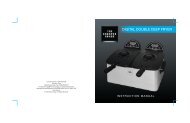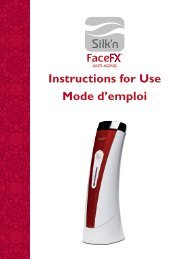Create successful ePaper yourself
Turn your PDF publications into a flip-book with our unique Google optimized e-Paper software.
<strong>User</strong> <strong>manual</strong> <strong>TRINITY</strong><br />
Page 1 of 5<br />
Dear Customer,<br />
<strong>TRINITY</strong> Stainless Steel<br />
Low-Pressure Cooker with Anti-Adhesion Coating<br />
Thank you very much for purchasing the <strong>TRINITY</strong> Pressure Cooker. In order to ensure safety and the<br />
longevity of this product, strict quality assurance procedures have been implemented during all production<br />
phases. If properly taken care of, this product can provide you with years of use and enjoyment. Please<br />
read this user <strong>manual</strong> carefully to understand the proper use and care for this product.<br />
ADVANTAGES OF THE <strong>TRINITY</strong> LOW-PRESSURE COOKER:<br />
Safety<br />
Contrary to traditional pressure cookers, only low pressure is generated in the <strong>TRINITY</strong> low-pressure<br />
cooker. The pressure built up inside approximately corresponds to the pressure inside a mineral water<br />
bottle. Besides the built-in permanent valve, an additional safety valve is integrated into the lid.<br />
Easy handling<br />
As opposed to traditional pressure cookers, you can remove the lid of the <strong>TRINITY</strong> Pressure Cooker while<br />
cooking since no significant pressure is built-up inside. Remove the pot from the stove, then remove its lid.<br />
You can now taste and re-season at will. No new recipes are needed – just use your favourite recipes and<br />
slowly adjust to the new style of cooking.<br />
Time-saving<br />
When using traditional cooking ware, a major part of the heat generated simply evaporates. Due to the<br />
permanent valve embedded in the lid, the <strong>TRINITY</strong> low pressure cooker regulates the evaporation of<br />
steam and heat, conserving up to 50% of time and energy requirements.<br />
Conserves taste<br />
Cook with only small amounts of additional water – most food (e.g. vegetables) contains large amounts of<br />
water. The built-in permanent valve controls the evaporation of steam. The steam remains inside the pot<br />
and condenses, i.e. forms small water droplets on the lid. Once these droplets cool down, they will fall<br />
back on the food being cooked inside the pot – a continuous process that helps prevent food from drying<br />
out. This will reduce your water usage and helping ensure your cooking retains much of its original taste<br />
and nutrients.<br />
COMPONENTS OF YOUR NEW <strong>TRINITY</strong> LOW PRESSURE COOKER:<br />
Permanent valve<br />
The permanent valve regulates the continuous pressure and reduces the evaporation of steam. The steam<br />
formed inside the pot activates a small piston inside the valve through which steam can evaporate. The<br />
heat built-up inside the pot remains and significantly reduces the cooking time.<br />
Safety valve<br />
An additional steam safety valve is embedded in the lid.<br />
Silicone Seal<br />
The lid is sealed with a silicone sealing ring attached to the inner side of the lid. This ensures a safe and<br />
airtight sealing of pot and lid.<br />
Extra-thick sandwich bottom<br />
The pot bottom is made of a massive aluminum core with an outer layer of stainless steel. The massive<br />
aluminum core stores the heat and evenly dissipates it along the pot’s contents. This helps prevents socalled<br />
“hot spots” that might lead to the food sticking to the pot bottom.
<strong>User</strong> <strong>manual</strong> <strong>TRINITY</strong><br />
Page 2 of 5<br />
Pot<br />
The pot is made of stainless steel with a high-polished outside that will provide for a deep and long-lasting<br />
shine as well as easy cleaning. An anti-adhesive coating prevents your cooking from sticking to the inner<br />
side of the pot. The anti-adhesive coating Teflon® Scratch-Guard® is a product of Du-Pont. Three layers<br />
of coating provide for a long-lasting and powerful anti-adhesion protection.<br />
Pot handles<br />
Put the stainless steel lid on top of the pot. Before cooking, always slide the upper side of the handles<br />
towards the lid’s center to close and lock the pot. Do not begin cooking before the pot is locked.<br />
Stainless steel lid with pressure cooking function<br />
The permanent valve is integrated into the stainless steel lid, which will rise when cooking begins to allow<br />
heat to escape. A transparent see-through glass in the lid provides for easy checking of the cooking<br />
process. The handles are made of heat-resistant plastic.<br />
Top handle of the stainless steel lid<br />
The top handle of the lid is ergonomically shaped and non-conductive to heat to help prevent burns when<br />
lifting the lid. This handle is extra-high to prevent your fingers touching the see-through glass when lifting<br />
the lid.<br />
See-through window<br />
The see-through window is heat resistant. It allows you to observe the cooking without removing the lid<br />
and thus interrupting the cooking process.<br />
Silicone sealing ring<br />
A silicone seal allows for a safe locking of the lid on the extra-wide rim of the pot lid.The silicone sealing<br />
ring can be easily removed and should be hand-cleaned with soap and water when needed. It should not<br />
be cleaned in dishwashers.<br />
Glass lid for traditional cooking (without picture)<br />
Use the supplied glass lid when not using the stainless steel lid. Using the glass lid while cooking can<br />
reduce time and energy. It is recommended to use the glass lid while cooking at high temperatures or with<br />
oil because the extreme heat can damage the silicone seal of the stainless steel lid. You should also use<br />
the glass lid when cooking food that easily foams or contains starch as this may block the valves of the<br />
stainless steel lid.<br />
Plastic lid (without picture)<br />
Use the supplied plastic lid only when storing food inside the pot to keep them fresh. The plastic lid is not<br />
to be used for cooking.
<strong>User</strong> <strong>manual</strong> <strong>TRINITY</strong><br />
Page 3 of 5<br />
Steaming insert (without picture)<br />
The steaming insert made of high-polished stainless steel is ideal for steaming vegetables or cooking rice<br />
and noodles. A steaming insert is provided with a handle.<br />
Hook (without picture)<br />
The hook made of stainless steel is easy for you to catch the handle of steaming insert without the risk of<br />
scald.<br />
BEFORE FIRST USE:<br />
Remove all stickers before first use. Then clean the <strong>TRINITY</strong> low-pressure cooker and its accessories with<br />
a mild cleaning liquid, rinse them with water and dry with a soft cloth.<br />
USAGE OF YOUR <strong>TRINITY</strong> LOW PRESSURE COOKER<br />
To ensure a perfect cooking result, it is imperative to have an even distribution of heat. This ensures that<br />
the pores of food inserted into the pot close immediately and that the food will not stick to the pot’s inner<br />
surface.<br />
The special sandwich-bottom of the pot assists in the fast and even distribution of heat that will prevent<br />
such adhesions. When you first use your <strong>TRINITY</strong> Pressure Cooker, begin with a lower setting and then<br />
adjust the stove settings to a low or medium temperature setting depending on your individual results.<br />
Tests have shown that medium settings will provide the best results when cooking. Due to the excellent<br />
heat dissipation of the pot’s bottom, food can even be cooked at low temperature.<br />
The best results will be achieved if you select a hob, or burner, that is slightly smaller than the pot’s bottom.<br />
When using a gas stove, adjust the flame to not exceed the pot’s bottom. Do not set the temperature too<br />
high to prevent stains on the cookware.<br />
Adjust the stove to high temperature to parboil the food briefly. Afterwards, reduce the stove temperature<br />
to a medium or low temperature setting; when using the stainless steel lid, the heat inside the pot will be<br />
sufficient for the food to remain at boiling point. Cooking at a temperature just below the boiling point is<br />
called ‘simmering’ and considered a gentle way of cooking food.<br />
The permanent valve provides for pressure-equalization and the stainless steel lid can therefore be<br />
removed occasionally while cooking. Removal of the lid will lower the temperature of the food inside the<br />
pot and may prolong your cooking time.<br />
The circulating condensation inside the pot will usually be sufficient water to cook the food. Only add small<br />
amounts of water to the food being cooked.<br />
Please observe the following:<br />
• Only fill the <strong>TRINITY</strong> Low-Pressure Cooker to a maximum of 2/3 of its total volume. When cooking<br />
food that foams or expands when cooked (e.g. rice), do not fill more than half of the pot’s volume. Do<br />
not overfill the pressure cooker.<br />
• The cooking time starts once the permanent valve opens. Please use the cooking table at the end of<br />
this <strong>manual</strong> as a reference.<br />
• Once the cooking time has started, you can reduce the stove’s temperature.<br />
• During the entire cooking process steam will evaporate through the permanent valve. This is normal<br />
and helps prevent pressure building up inside the pot. Should the permanent valve not open (rise) or<br />
if steam evaporates from the sides of the lid, terminate the cooking process immediately. Remove the<br />
pot from the stove and let it cool down. Check the valve and clean it if necessary. Check if the<br />
silicone sealing ring is properly inserted before restarting the cooking process.<br />
• After the cooking time has ended remove the pot from the stove. Place it on an even and heatresistant<br />
surface. Open the lid and let the steam evaporate. Always open the lid towards yourself<br />
with the opening facing away from you – this may prevent burns from the evaporating residual<br />
steam. Use good safety precautions when dealing with the cooker’s contents, as your food will be hot.<br />
• When preparing food that requires fat or oil to be heated, do not use the stainless steel lid. The<br />
silicone sealing ring may be damaged by the excessive heat generated when cooking.<br />
• When roasting food always use the glass lid. Do not use the stainless steel lid as the silicone sealing<br />
ring may be damaged by the heat.<br />
Cooking utensils:
<strong>User</strong> <strong>manual</strong> <strong>TRINITY</strong><br />
Page 4 of 5<br />
Even though this product is metal utensil safe we recommend using wooden / heat-resistant plastic /<br />
silicone cooking utensils.<br />
CLEANING<br />
Except for the silicone sealing ring, your <strong>TRINITY</strong> low-pressure cooker can be cleaned in a dishwasher.<br />
However, the set is so easy to clean that we recommend cleaning it by hand for the best possible results.<br />
When finished cooking, remove the low-pressure cooker from the stove and let it cool down on a heatresistant<br />
and even surface. Do not add or pour cold water into the hot pot as the sudden temperature<br />
change may damage the bottom of the pot or hot fat may spatter.<br />
Removing stains<br />
Clean the low-pressure cooker after each cooking and remove all remains of food or fat particles. If those<br />
remains are not removed carefully, these may burn into the bottom of the pot during subsequent use and<br />
lead to stains in your cookware. Stains on the bottom part of the pot can be removed with a special<br />
cleanser for stainless steel objects.<br />
Stains in the form of a white film (caused by minerals contained in water or starch) may occasionally occur.<br />
This white film may be removed with a sponge dipped in lemon juice or vinegar. Afterwards clean the lowpressure<br />
cooker as usual, rinse with water and dry it afterwards with a soft cloth. Do not store your<br />
pressure cooker until it is completely dry.<br />
Care of handles<br />
While cooking, ensure that the handles are never placed directly above a heat source in order to prevent<br />
gas flames from reaching beyond the bottom surface and overheating the handles.<br />
SAFETY PRECAUTIONS<br />
• Use the <strong>TRINITY</strong> Low-Pressure Cooker exclusively for the preparation of food. Observe the<br />
instructions for use and maintenance described in this <strong>manual</strong>.<br />
• Never leave the <strong>TRINITY</strong> Low-Pressure Cooker unattended during use. Never leave an empty lowpressure<br />
cooker on a hot stovetop. This may lead to stains or damage to the product.<br />
• Beware of handles overlapping the stove. They might get caught up in clothing or be inadvertently<br />
pulled down by children.<br />
• Before each use, carefully check the silicone seal for nicks, cracks or other signs of excessive wear or<br />
damage. Do not use if seal appears damaged.<br />
• Do not use the cooker without safety seal.<br />
• Before each use, check the safety valves. Do not use your cooker if you see any signs of clogging,<br />
cracks or other damage to the safety valves.<br />
• Always place the handles away from a heat source to prevent overheating of the handle.<br />
• Be careful when moving the low-pressure cooker as long as it is still filled with hot liquids or fat. Always<br />
hold the pot with both handles<br />
• When using the stainless steel lid, push the handle lock towards the center of the lid to safely lock it in<br />
place.<br />
• Remove the lid by pushing the handle locks away from the center. When removing the lid, open it<br />
facing away from you. Direct contact with steam can lead to severe burns. Wear oven mitts for extra<br />
protection.<br />
• Do not store your cookware in wet or humid environments or near potential heatsources. To prevent<br />
scratches in storage, place paper towels betweens your pots.<br />
• Do not use your <strong>TRINITY</strong> low pressure cooker in an oven, microwave oven or camping fire. This lowpressure<br />
cooker is to be used exclusively on stoves in non-professional kitchens.<br />
• Be careful when using cookware with mechanically produced bottoms on ceramic-surface stoves. The<br />
bottom of the pot ought to be dry before being placed on the stove.<br />
• Metal surfaces such as the bottom of your low-pressure cooker can be highly reflective when new. This<br />
may affect the efficiency when cooking on certain halogen stoves. Read the <strong>manual</strong> of your halogen<br />
stove for possible assistance.<br />
• The <strong>TRINITY</strong> low-pressure cooker is suitable for gas, electric, induction and ceramic top stoves.
<strong>User</strong> <strong>manual</strong> <strong>TRINITY</strong><br />
Page 5 of 5<br />
Cooking Timetable:<br />
The below mentioned cooking times are only for reference. The required cooking time may be reduced up<br />
to 50% depending on your individual way of cooking.<br />
Regular cooking time Cooking time with the lowpressure<br />
cooker<br />
Stocks<br />
Vegetable stock 1 to 2 hours 30 minutes<br />
Chicken stock 1 to 2 hours 1 hour<br />
Beef stock several hours 1 hour<br />
Fish stock 2 to 3 hours 30 minutes<br />
Soups<br />
Vegetable soup 1 to 2 hours 30 minutes<br />
Chicken soup 1 to 2 hours 30 minutes<br />
Beef soup 1 to 2 hours 30 minutes<br />
Vegetables<br />
Carrots 12 minutes 6 minutes<br />
Corn cobs 12 minutes 7 minutes<br />
Asparagus 5 minutes 3 minutes<br />
Mashed potatoes 20 minutes 12 minutes<br />
Turnips 45 minutes 30 minutes<br />
Broccoli 6 minutes 4 minutes<br />
Brussel sprouts 30 minutes 15 minutes<br />
Eggplant 7 minutes 4 minutes<br />
Potatoes 20 minutes 12 minutes<br />
Zucchini 4 minutes 2 minutes<br />
Artichokes 1 hour 30 minutes<br />
Meats and Fish<br />
Pork knuckles 2 to 2,5 hours 60 minutes<br />
Ribs 1 hour 30 minutes<br />
Goulash 90 minutes 40 minutes<br />
Chicken breast without bones 10 minutes 6 minutes<br />
Chicken legs 25 minutes 15 minutes<br />
Chicken Cacciatore 60 minutes 30 minutes<br />
Salmon steaks 4 to 6 minutes 2 to 3 minutes<br />
Shrimps (medium-sized) 2 minutes 1 minute<br />
Lobster 8 minutes 4 minutes<br />
Beans<br />
Kidney beans 1 to 1,5 hours 40 minutes<br />
Large beans 90 minutes 50 minutes<br />
Rice dishes<br />
Risotto 24 minutes 17 minutes<br />
Long-grain rice 24 to 30 minutes 15 to 20 minutes<br />
Natural rice 30 minutes 22 minutes<br />
Wild rice 1 hour 35 minutes









